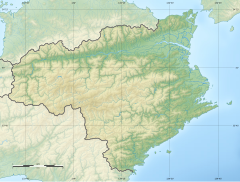Ryōzen-ji (Naruto)
| Ryōzen-ji | |
|---|---|
霊山寺 | |
 Pilgrims (henro) at Ryōzen-ji | |
| Religion | |
| Affiliation | Buddhism |
| Sect | Kōyasan Shingon |
| Deity | Shaka Nyorai |
| Location | |
| Location | Naruto, Tokushima Prefecture |
| Country | Japan |
| Geographic coordinates | 34°9′35.29″N 134°30′9.33″E / 34.1598028°N 134.5025917°E |
| Architecture | |
| Founder | Gyōki |
| Completed | 729-749 |
Ryōzen-ji (Japanese: 霊山寺, lit. 'Vulture Peak Temple') is a Shingon Buddhist temple in Naruto, Tokushima Prefecture, Japan best known as the first temple of the Shikoku pilgrimage. It is associated with the Kōyasan sect and dedicated to Shaka Nyorai.
Said to have been founded by Gyōki during the Tenpyō era, its buildings are more recent replacements after damage by fires.[1][2][3] Located close to the crossing point for pilgrims from the Kansai region, Yūben Shinnen identified the temple as No.1 in his Shikoku henro michishirube of 1687 and subsequent guidebooks followed suit.[4] It is customary to return to Ryōzen-ji on a 'thanksgiving visit' (orei mairi) upon completing the pilgrimage, although this may be a relatively recent development.[5][6]
See also
[edit]- Tōrin-in, the temple's oku-no-in
References
[edit]- ^ "Ryōzen-ji". Naruto City. Archived from the original on 6 October 2011. Retrieved 24 April 2011.
- ^ Miyata, Taisen (2006). The 88 Temples of Shikoku Island, Japan. Koyasan Buddhist Temple, Los Angeles. p. 44.
- ^ Miyazaki, Tateki (2004). Shikoku henro hitori aruki dōgyō-ninin. Matsuyama. p. 42.
- ^ Reader, Ian (2005). Making Pilgrimages: Meaning and Practice in Shikoku. University of Hawaii Press. pp. 116, 127. ISBN 978-0-8248-2907-0.
- ^ Reader, Ian (2005). Making Pilgrimages: Meaning and Practice in Shikoku. University of Hawaii Press. pp. 13–14. ISBN 978-0-8248-2907-0.
- ^ "Centre for the Study of Japanese Religions - Jan 07 Newsletter (p.31)" (PDF). SOAS. Retrieved 24 April 2011.

